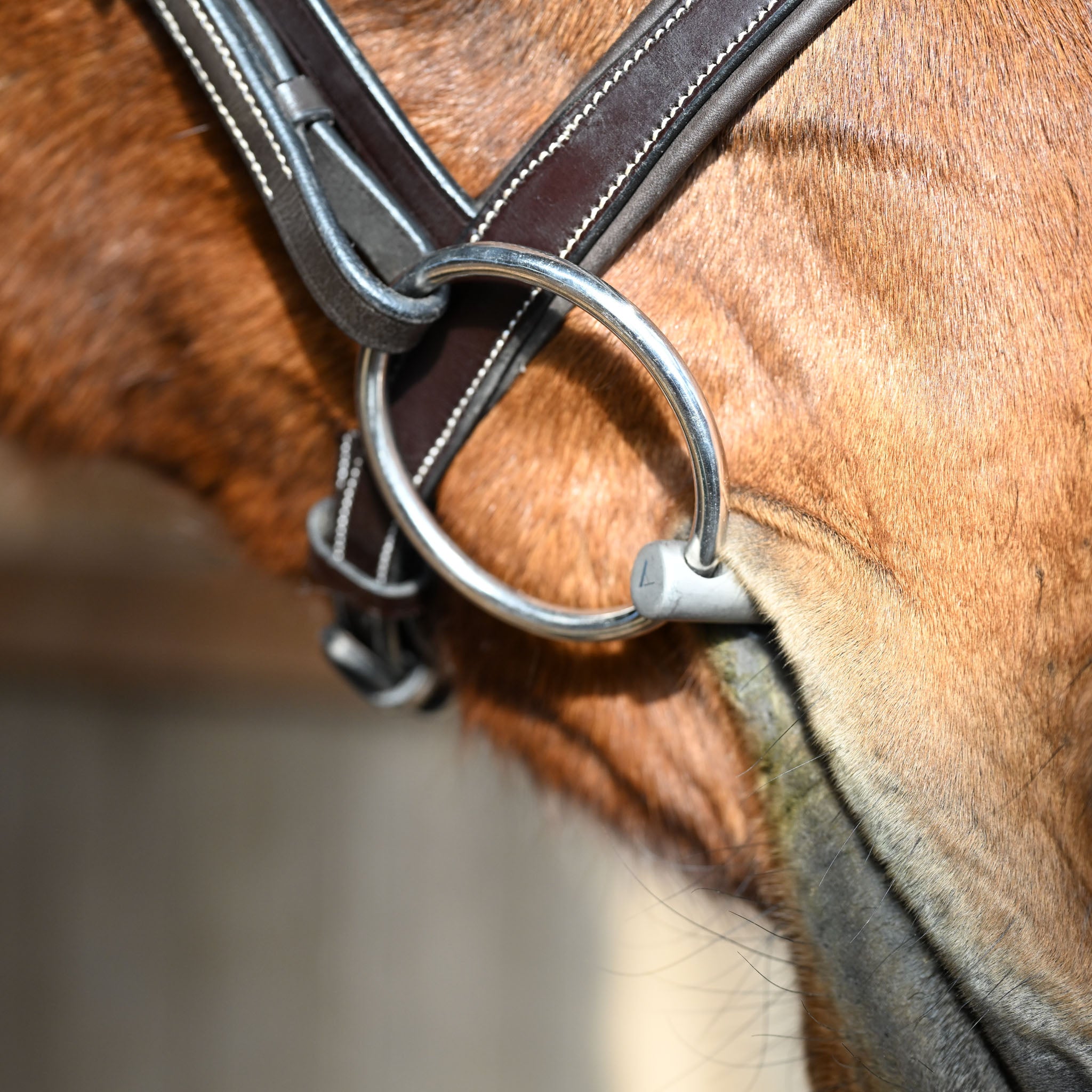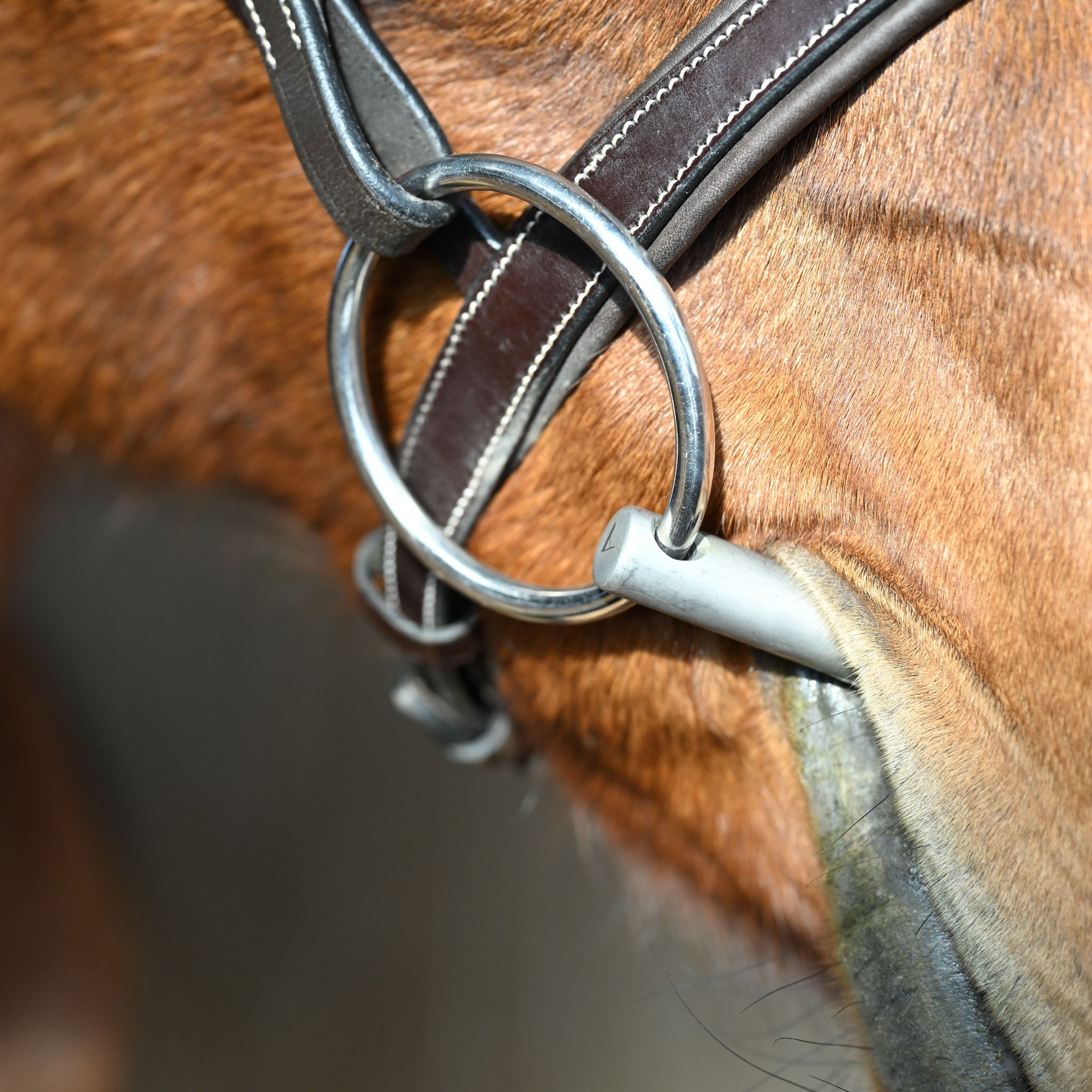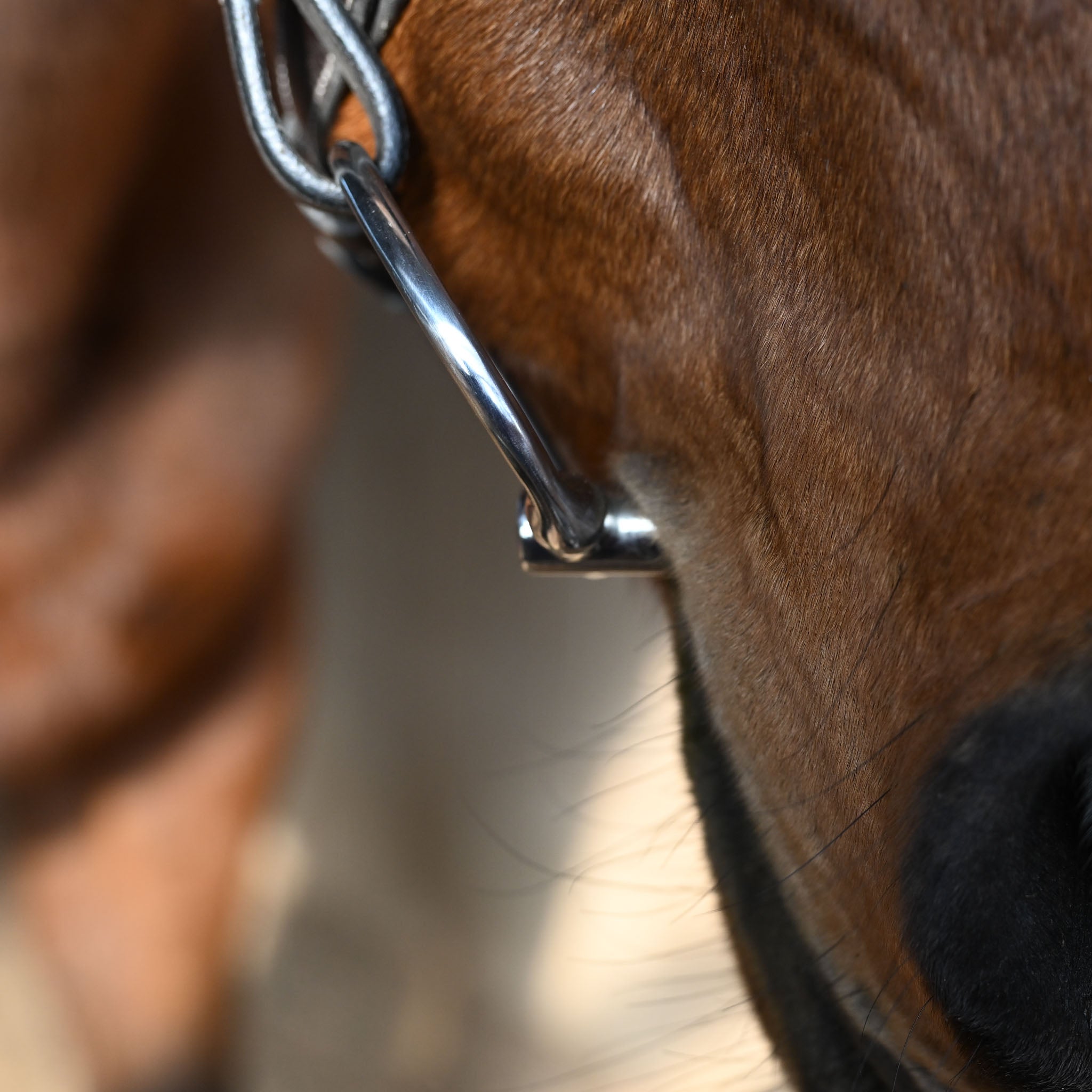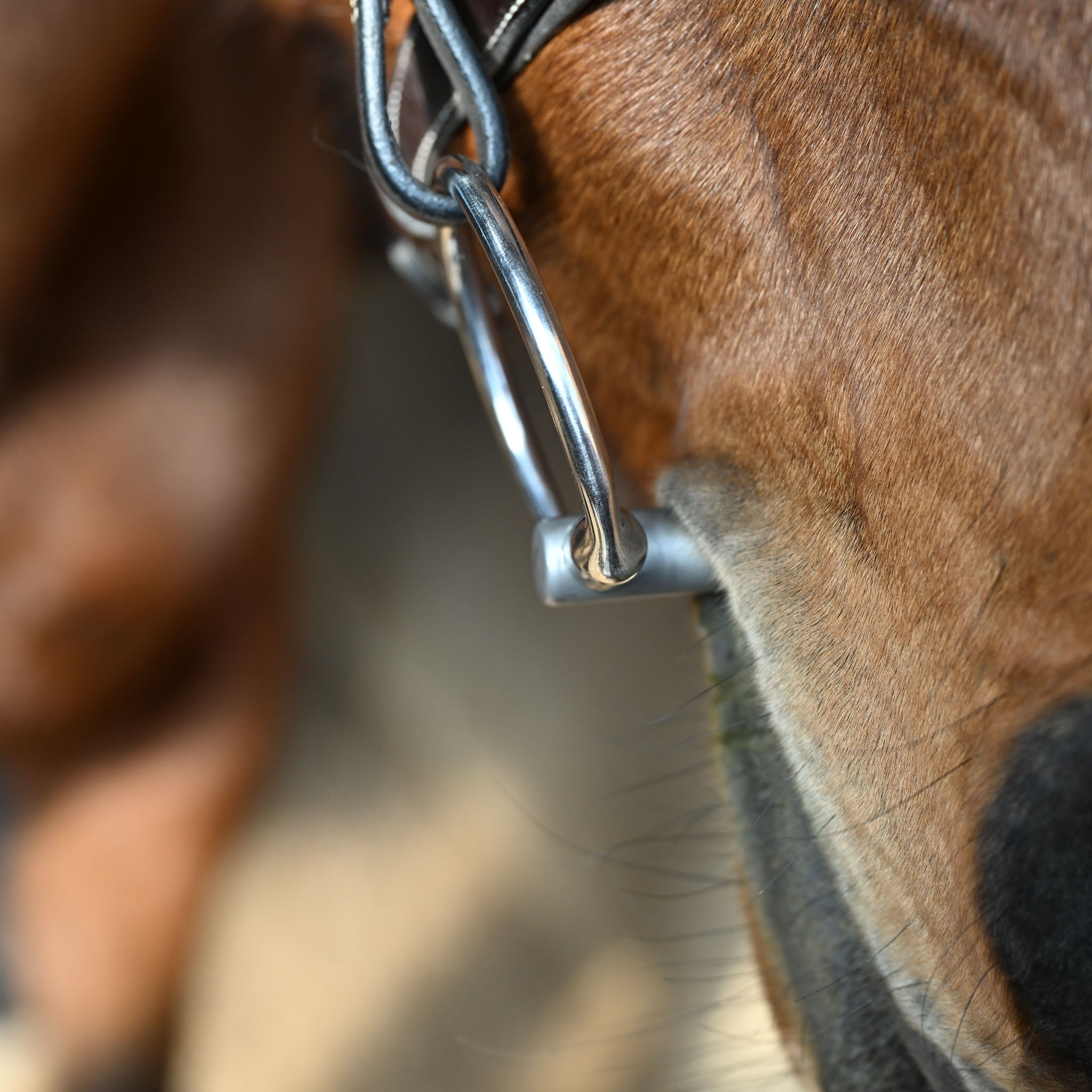A Guide For Riders and Horse Owners
How to Make Sure Your Bit Fits Correctly
Proper bit sizing is crucial for your horse's comfort and effective communication. An incorrectly sized bit can cause discomfort, mixed signals, and poor response to aids. Two key aspects determine proper bit fit: width (the length of the mouthpiece) and thickness (the diameter of the cannons).
While width ensures proper placement and function, thickness plays a vital role in comfort - especially considering the limited space between your horse's tongue and palate. As shown in anatomical studies, horses typically have only 25-44mm of space between their upper and lower jaws and most of it is taken up by the tongue. Finding the right balance between these measurements will help ensure both comfort and clear communication.
Let's first examine how different sizes appear for both loose ring and fixed ring bits, helping you identify the optimal fit for your horse.
If you are using any bit with sliding rings -loose ring, elevator, polo gag, beval etc.
Assessing Loose Ring Fit

Too Small
The rings press against the horse's lips, possibly pinching the corners of lips when the ring rotates with rein engagement. The confined movement prevents the bit's natural rotation and reduces the pre-signals that loose rings are designed to provide. This can lead to rubs or sores at the corners of the mouth.

Just Right
The rings sit comfortably against the lips with about 1/8-1/4 inch clearance on each side. This allows proper rotation and movement while maintaining clear communication. The bit can slide smoothly through the rings without pinching or binding.

Too Big
The bit that's too large will shift in horses mouth and ceate delayed or unclear signals. The loose fit allows the bit to slide around excessively in the mouth, making it difficult for the horse to understand and respond to rein aids.
If you are using any bit with fixed rings - eggbutt, dee, baucher, pelham, kimberwick etc.
Assessing Fixed Ring Fit

Too Small
The short mouthpiece pushes against the lips, creating uncomfortable pressure points. This can lead to rubs or sores at the corners of the mouth when riding.

Just Right
The mouthpiece extends just past the cheeks, allowing minimal movement while maintaining stability. This fit ensures clear communication while preventing the bit from sliding excessively.

Too Big
The oversized mouthpiece creates too much side-to-side movement despite the fixed rings. This excess play can cause the bit to slide across the bars unevenly and makes it difficult to give clear, precise signals.
Pro tip: size up for a loose ring bit
As you can see from images and explanations, if you are switching from a fixed ring bit to a loose ring, it is wise to size up to allow the extra space for the loose rings to slide freely.
If you are moving from a well-fitted loose ring bit to a fixed ring, you may want to consider sizing down.
Mouthpiece Thickness
Understanding Thickness
A groundbreaking study* about 20 years ago examined 72 cadevers of horses and revealed some fascinating insights about equine mouth anatomy that challenge common assumptions about bit fitting.
The study found that most adult horses have between 25-44mm of space between their upper and lower jaws (averaging 34mm), with ponies ranging from 26-43mm (averaging 32mm). Remember that the tongue occupies much of this space, leaving limited room for a bit.
Most surprisingly, ponies and full-sized horses have remarkably similar internal mouth measurements. While a pony's head might be significantly smaller externally, they typically have only 2-3mm less space between their upper and lower jaws compared to larger horses.
Another key finding was that individual horses can have up to 6mm difference between the left and right sides of their mouths. This asymmetry might explain why some horses seem more comfortable with contact on one side versus the other.
Perhaps most importantly for bit fitting, the researchers found no reliable correlation between external head size and internal mouth space. This means you cannot determine appropriate bit size simply by looking at your horse's head shape or size.
These findings explain why thick bits (often recommended for sensitive horses) can actually cause more problems than they solve - there simply isn't enough space in many horses' mouths to accommodate them comfortably.
What does this mean for you? Whether you have a pony or a draft horse, their comfort with a bit depends more on their individual mouth conformation than their size or breed. Taking the time to assess the space in your horse's mouth, rather than making assumptions based on their appearance, will help you make better choices about bit thickness and design.
*Engelke, E. and Gasse, H. (2003). An anatomical study of the rostral part of the equine oral cavity with respect to position and size of a snaffle bit. Equine Veterinary Education, 15(3), 158-163.
Quick Assessment Guide
One easy way to assess the available space in your horse’s mouth is by gently placing a finger between the horse’s tongue and palate (where the bit rests). This gives you a general sense of how much room the horse has to accommodate a bit. If you want to be precise or your fingers are not average sized, use the caliper tool to determine thickness or a soft tape (measure your circumference at the middle of the finger and divide by 3).
Watch this video on how to use the finger test. Try to check both sides to figure out if you feel any asymmetries. If there are asymmetries always use the smaller side for your measurement reference. Be careful when doing this to avoid getting bitten, and ensure the horse is calm and relaxed.
Below we discuss your findings and appropriate thickness to try.
Tight fit (10-12mm ideal)
- One finger feels tight.
- Appears to have low palate and/or fleshy tongue.
- Often shows resistance to traditional bits.
- May chomp or pull against contact.
Average fit (12-15mm ideal)
- One finger feels like a well fitting shoe - not too loose but also not too tight.
- Most common mouth type.
- Generally accepts standard bits well.
- Flexible sizing options.
Generous fit (15mm+ ideal)
- Good amount of wiggle room, think, a shoe that's a size too big or more.
- Can accommodate thicker bits.
- Thin-tongued horses often prefer thicker bits for bar cushioning.
- May hide behind contact if bit is too thin.
How We Measure Our Bits
At Agador's, we measure every bit consistently to ensure you get exactly what your horse needs. Our measurements follow industry standards while accounting for design variations that can affect fit.
Key Measurements:
- Mouthpiece width (critical for proper fit)
- Thickness at various points
- Ring size
- Shank Length
Understanding how we measure helps you:
- Compare bits accurately across styles
- Order the correct size with confidence
- Ensure consistent fit when replacing bits
- Account for design features that affect sizing
Let's explore how each measurement is taken.
Mouthpiece Length
We measure mouthpiece length from ring to ring for both fixed and loose ring mouthpieces.

Mouthpiece Thickness
We measure mouthpiece thickness at the point closest to the cheekpiece using a calliper measuring tool with mm precision.

Ring Size

All our measurements for ring sizes are inside to inside.

For D Ring bits we measure both height and width.
Cheekpiece Height
Shank Length is measured as follows:

We measure Cheekpiece Height: Top To Mouthpiece of our Baucher Bits as follows:

Final Remarks
We strive to provide key measurements for all bits we sell as part of our product descriptions.
If you have any questions or would like to have a specific bit measured please do not hesitate to contact us via email. We generally respond to inquiries within a 24hr window.
Finally, please note that while we make our best effort to have all bits be equally sized and comparable, from time to time there might be slight variations and deviations as every Agador's bit is handmade.
